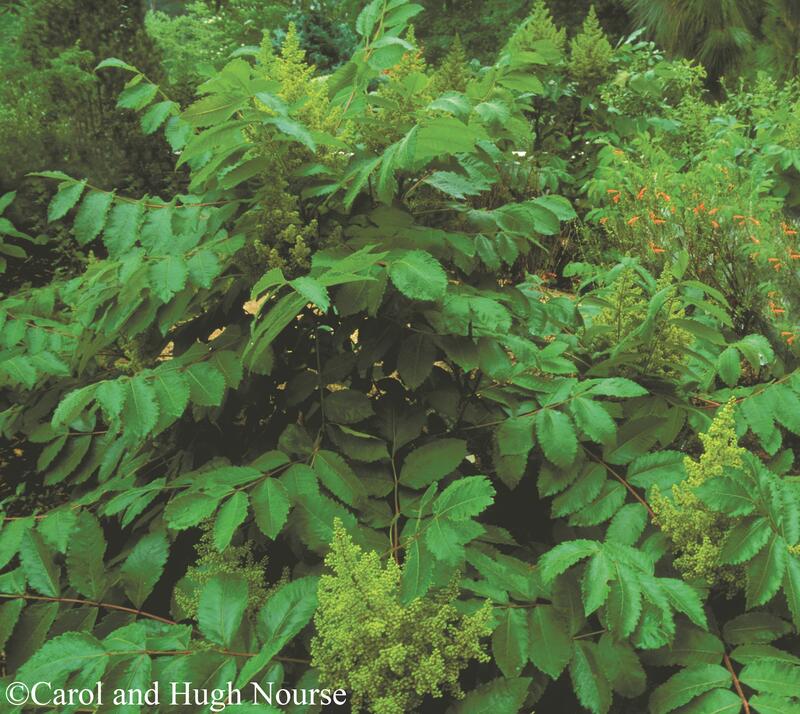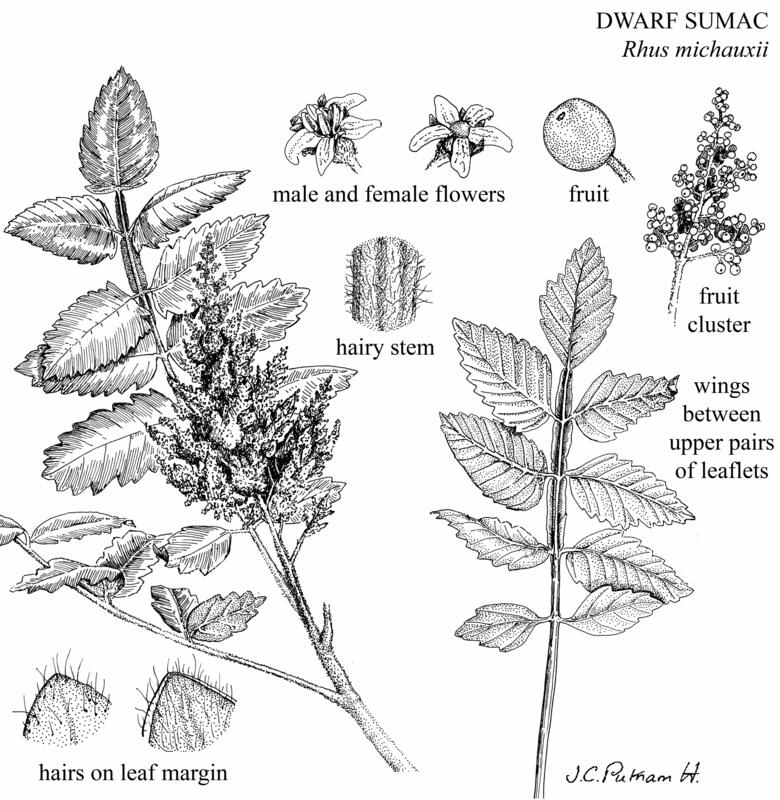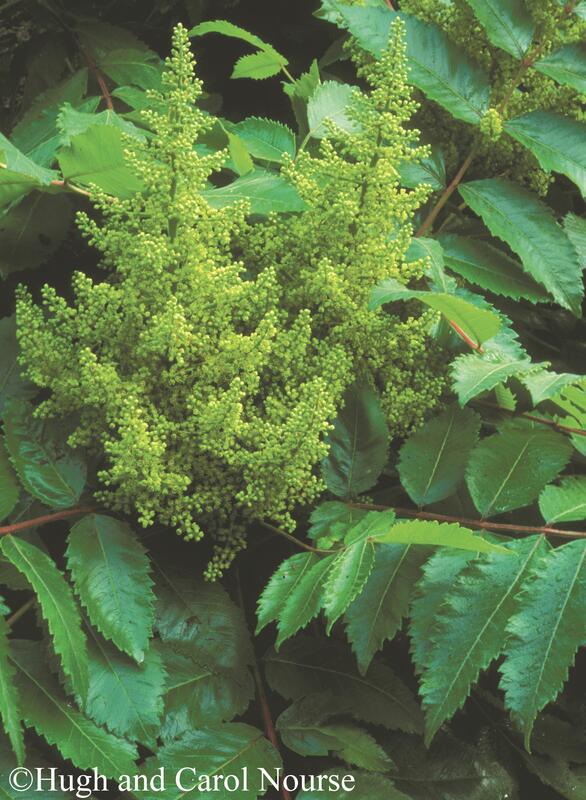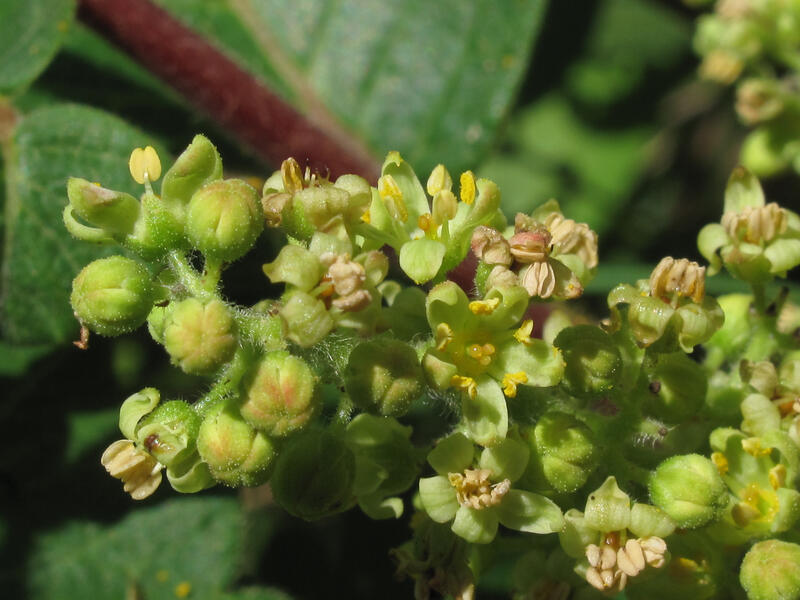







Loading profile. Please wait . . .
Rhus michauxii Sarg.
Dwarf Sumac




Federal Protection: Listed Endangered
State Protection: Endangered
Global Rank: G2G3
State Rank: S1
Element Locations Tracked in Biotics: Yes
SWAP 2015 Species of Greatest Conservation Need (SGCN): Yes
SWAP 2025 Species of Greatest Conservation Need (SGCN): Yes
2025 SGCN Priority Tier: Highest Conservation Concern
Element Occurrences (EOs) in Georgia: 14
Habitat Summary for element in Georgia: Open forests over ultramafic rock
Colonial shrub with erect stems 1 - 3 feet (30 - 90 cm) tall; young shoots have a reddish tinge. Its leaves are deciduous, alternate, and compound with 9 - 13 leaflets on a reddish leaf stalk. The leaf stalk is winged only between the 2 or 3 uppermost pairs of leaflets near the leaf tip. The leaflets are 1.6 - 3.5 inches (4 - 9 cm) long, oval to oblong, sharply toothed, mostly opposite; with very short or no stalks except the terminal leaflet which has a winged stalk 2 inches (5 cm) long. Female and male flowers are on separate plants, both in dense, tightly branched clusters at the top of the stem; all flowers have 4 - 5 tiny, greenish-yellow petals. Fruits are less than 0.25 inch (5 - 6 mm) long, dark red, in dense clusters. All parts of the plant – stems, leaves, stalks, and fruit – are densely hairy.
Winged Sumac (Rhus copallina) is a tall, colonial shrub with hairy stems up to 20 feet (6 meters) tall; its leaves have wings on the rachis between each pair of its lance-shaped leaflets, which are pale green beneath and not toothed.
Smooth Sumac (Rhus glabra) is also a tall, colonial shrub but its stems and leaves are hairless and its long, lance-shaped leaflets lack teeth; it does not have wings between its leaflets.
Staghorn Sumac (Rhus typhina, Special Concern) is a shrub or small tree to 30 feet (9 meters) tall with very hairy stems, smooth leaves with no wings, and 15 - 31 long-pointed, toothed leaflets. It occurs in open mountain forests in Murray, Fannin, Lumpkin, Towns, and White Counties. For more information, see: https://en.wikipedia.org/wiki/Rhus_typhina
Dry, open, rocky, or sandy woodlands over mafic bedrock with high levels of calcium, magnesium, or iron; often on ridges and river bluffs.
Dwarf Sumac is dioecious – female flowers and male flowers are produced on separate plants. Because of habitat fragmentation, female and male plants are often isolated from one another and the plants cannot reproduce sexually. (Some plants may also be hermaphroditic – changing sex from year to year – and a few plants may be monoecious.) Plants spread vegetatively by extending underground stems (rhizomes) as much as 20 feet away. Although some large, mixed-sex populations of Dwarf Sumac produce fruit, the seeds are often sterile. Pollinators and seed dispersers are unknown but the flowers of other sumac species are visited by bees, and their fruits are dispersed by birds. Where Dwarf Sumac occurs with Smooth Sumac (Rhus glabra), the two may hybridize.
Flowers June–August, fruits August–October. Plants may be identified throughout the growing season by leaf and stem characteristics.
Georgia, North Carolina, and Virginia; extirpated from Florida.
Conversion of habitat to residential and commercial developments and pine plantations, clearcutting, broadcast herbicide use.
| Threat 1 | Threat 2 | Threat 3 | |
|---|---|---|---|
| General Threat | Invasive & other problematic species, genes & diseases | Climate change & severe weather | None |
| Specific Threat | None | None | None |
Rhus michauxii is ranked S1 by the Georgia Department of Natural Resources, indicating that it is critically imperiled in Georgia. Georgia has two small extant populations of Dwarf Sumac; three other populations were destroyed.
One population, in Newton County, with only female plants was threatened by a construction project; the plants were rescued from that population and safeguarded until construction was over, when the plants were successfully re-introduced to the site. The other extant Georgia population, 80 miles away on conservation land in Elbert County, had only male-flowered plants. Female plants from the Newton County site were introduced to the site in 2009 and have successfully established and reproduced. Ongoing restoration efforts at that site include prescribed fire, monitoring, and invasive plant removal. Several other safeguarding populations on conservation lands have been established since.
Dwarf Sumac is intolerant of shade and requires fire or hand-clearing to maintain sunny conditions. Clear competing vegetation by hand or with prescribed fire. Avoid mechanical clearing and the use of heavy equipment in its habitat.
Barden, L.S. and J.F. Matthews. 2004. Andre Michaux’s sumac – Rhus michauxii Sargent: why did Sargent rename it and where did Michaux find it? Castanea 69(2): 109-115. https://doi.org/10.2179/0008-7475(2004)069%3C0109:AMSMSW%3E2.0.CO;2
Burke, J.M. and J.L. Hamrick. 2002. Genetic variation and evidence of hybridization in the genus Rhus (Anacardiaceae). Journal of Heredity 93(1): 37-41. https://academic.oup.com/jhered/article/93/1/37/2187277
Chafin, L.G. 2007. Field guide to the rare plants of Georgia. State Botanical Garden of Georgia and University of Georgia Press, Athens.
GADNR. 2020. Element occurrence records for Rhus michauxii. Georgia Department of Natural Resources, Wildlife Resources Division, Social Circle, Georgia.
NatureServe. 2019. Rhus michauxii comprehensive report. NatureServe Explorer. Arlington, Virginia. http://explorer.natureserve.org/servlet/NatureServe?searchName=Rhus+michauxii
North Carolina Natural Heritage Program. 2001. Guide to federally listed endangered and threatened species of North Carolina. North Carolina Natural Heritage Program, Raleigh, North Carolina.
Patrick, T.S., J.R. Allison, and G.A. Krakow. 1995. Protected plants of Georgia. Georgia Department of Natural Resources, Natural Heritage Program, Social Circle.
USFWS. 2019. Michaux’s sumac (Rhus michauxii) species profile and related documents. U.S. Fish and Wildlife Service, Washington D.C. https://ecos.fws.gov/ecp0/profile/speciesProfile?sId=5217
Weakley, A.S. 2008. Flora of the Carolinas, Virginia, Georgia, northern Florida, and surrounding areas. University of North Carolina Herbarium, Chapel Hill. http://www.herbarium.unc.edu/flora.htm
Linda G. Chafin
L. Chafin, Jul. 2008: original account
L. Chafin, Oct. 2009: updated account
K. Owers, Feb. 2010: added pictures
Z. Abouhamdan, Apr. 2016: updated link
L. Chafin, Jun. 2020: updated original account



